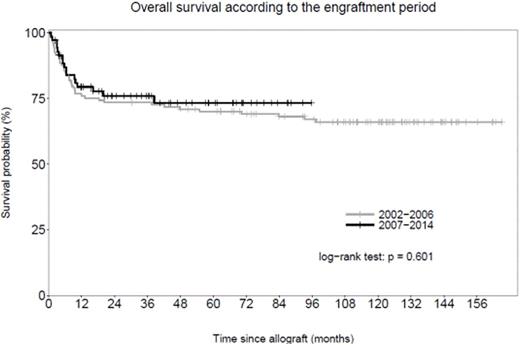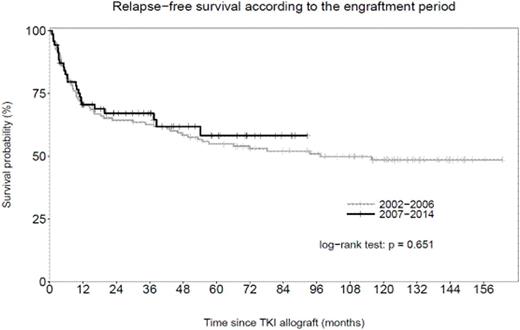Abstract
Background & aims
The only curative treatment of CML to date, remains allogeneic stem cell transplantation (Allo-SCT) despite some observations of non-detectable disease recurrence after tyrosine kinase inhibitor (TKI) cessation. The scope of allogeneic stem cell transplant for chronic phase (CP-) CML remains debatable and it seems interesting to retrospectively analyse the settings of this procedure in such patients since the introduction of TKI within the therapeutic arsenal of this disease.
Methods
We retrospectively analysed the registry of the Francophone society of stem cell transplantation and cellular therapy (SFGM-TC) from 2002 to 2014, for patients being in CP at diagnosis and at transplant. All data were captured according to thefrench regulations and were collected after signed up informed consent for each patient. All patients were transplanted for different degrees of resistance or severe recurrent intolerance to TKI(s). We segmented the observation period into two parts: 2002-2006 (Imatinib era) and 2006-2014, once second generation TKI were available in our country (TKI2 era). All patients were in CP-CML at diagnosis and first chronic phase at transplant. Second transplants for the same patient were excluded from this analysis.
Results
From 2002 to 2014 the proportion of transplants for CML dramatically decreased form 7.1% to <3% of totalallo-SCT performed in the country. Nevertheless, between 2002 and 2014, 191 transplants were performed for CP-CML, 121 during the first period and 70 during the second period. Interestingly, age at transplant is 36 (26-43) for IM period and older, 44 (26-55) years for TKI2 period; with a sex ratio of 1.08 and 1.3 respectively (p=ns). The median interval between diagnosis and transplant was 19 (1.4-197) months for IM period and much longer thereafter[32 (6.6-194) months, p<0.001]. The source of cells varied a lot with 71% of BM, 25.5% PBSC and 3.5% CB for IM period, 37% BM, 56% PBSC and 7% CB for TKI2 period (p<0.001), whereas the proportion of MAC versus RIC remained stable (88.5%/11.5% versus 81%/19%, p=0.262). The use of TBI as a part of the conditioning regimen was drastically reduced during the second period: 37% IM era, 14% TKI2 era (p<001). While ABO match did not differ, the use of unrelated donors largely increased in the second period (66% versus 46%, p=0.015), with less identical sibling donors used (33% versus 52%) in this last period. The proportion of sex match did not differ with a majority of male to male transplants (28% and 37%; p=ns) performed in both groups. The majority of patients wereGratwohlscore 3 in IM period andGratwohlscore 4 in the second period. Overall, the cumulative incidence of grade 2-4 acute GVHD was 32%, 41.3% and 44% at 1,2 and 3 months respectively, and the overall cumulative incidence of chronic GVHD was 26%, 40%, 45%, 50% at 1, 2, 5, and 10 years. The TRM rates were not different between the 2 periods: 22.4%, 23%, 26.65% and 27.8% at 1, 2, 5 and 10 years for IM period and 16.2%, 19.7%, 22.4% and 27.8% at 1, 2, 5 years for TKI2 period (NR 10 year for this period, p=0.508).The overall (OS) and relapse-free survival (RFS) rates according to the two periods are shown in Figure 1, with only a trend in the improvement of OS and RFS in the TKI2 period (log-rank tests, p=0.601 and 0.651 respectively).Gratwohlscore efficiently segregated patients for OS (overall p value = 0.002) and RFS (p=0.007). Multivariate analysis adjusted on OS identified only age (HR=1.02, p=0.05), and a related donor as a favourable variable on outcome (HR=0.53, p=0.031) with no significant influence of age, interval diagnosis-allo-SCT, source of donor cells, and type of conditioning regimen.
Conclusion
Allo-SCT still remains a curative treatment of CP-CML despite significant toxicities over time and the picture of this procedure in the therapeutic arsenal has dramatically changed over the last decade due to multiple therapeutic options offered now. Despiteallo-SCT of patients with longer diseases histories, probably more co-morbidities, there is an encouraging trend in the improvement of OS and RFS.
Nicolini:BMS: Consultancy, Honoraria; Ariad: Honoraria, Membership on an entity's Board of Directors or advisory committees; Novartis: Honoraria, Membership on an entity's Board of Directors or advisory committees, Research Funding. Coiteux:Novartis, BMS, ARIAD: Speakers Bureau. Michallet:Bristol-Myers Squibb: Consultancy, Honoraria, Research Funding; Pfizer: Consultancy, Honoraria; Novartis: Consultancy, Honoraria; Pfizer: Consultancy, Honoraria; Astellas Pharma: Consultancy, Honoraria; MSD: Consultancy, Honoraria; Genzyme: Consultancy, Honoraria. Peffault De Latour:Novartis: Consultancy, Honoraria, Research Funding; Alexion: Consultancy, Honoraria, Research Funding; Amgen: Research Funding; Pfizer: Consultancy, Honoraria, Research Funding.
Author notes
Asterisk with author names denotes non-ASH members.



This feature is available to Subscribers Only
Sign In or Create an Account Close Modal